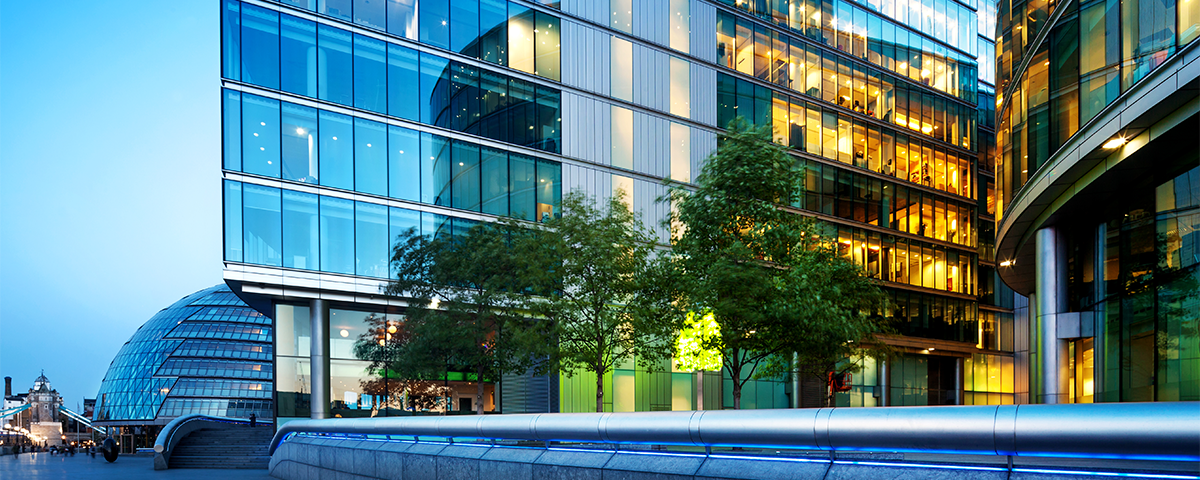
By 2050, it is estimated that 85 per cent of occupied buildings will be those that exist today. With the UK Government introducing a legally binding target to reduce Greenhouse Gas (GHG) emissions to Net Zero by 2050 it is essential that we start to look now at how current buildings can meet these requirements
Steven Thomas – Associate Director of Net Zero Services at Tetra Tech – has 20 years of experience as an energy consultant. With a background in energy efficiency and decentralised energy systems, Steven explores what commercial building owners and landlords must consider on their own journeys to Net Zero.
What current and forthcoming legislation do commercial landlords need to be aware of with regards to energy efficiency and net zero?
The Minimum Energy Efficiency Standards (MEES) currently require Commercial Landlords to achieve an Energy Performance Certificate (EPC) rating of E or better to create or renew tenancies. However, the Government will update the MEES scheme in 2023 to cover all commercial leases, and intends to raise the minimum standard to a D by 2025 and a C Rating by 2030. This is a key stimulant for a programme of retro-fit to improve the energy efficiency of existing commercial building stock.
Elsewhere, the Future Buildings Standard (FBS) covers the revision of Part L of the Building Regulations for commercial buildings but hasn’t had any major revisions since 2013.
However, there is a new consultation into FBS which proposes new energy efficiency standards in 2021 to support delivery of “zero carbon ready” buildings, with new reduction targets for commercial buildings likely to be 27% compared to the existing Part L standard. These are designed to encourage more efficient building services, building fabric improvements and on-site low carbon technology such as heat pumps or solar PV systems.
What are the challenges in retro-fitting commercial properties to meet these standards and what can be done to overcome them?
Retro-fitting existing urban building stock to achieve Net Zero Emissions can present several difficulties:
- Many older buildings were built when energy efficiency and sustainability were low on the agenda. This includes the building envelope and building services, and can result in insufficient plantroom and riser space, or structural limitations on weights on roofs.
- Urban conglomerated areas often have limited external space for renewable technologies.
- Historically, in the UK, Ground Source Heat Pumps (GSHPs) were not as reliable and were susceptible to operating faults and maintenance issues
- Retro-fitting projects is often more expensive than building from scratch due to the limitations and confines of working in existing buildings with existing functional systems. Carrying out projects in the existing facilities also causes disruptions to end users.
In addition, focusing on demand reduction measures alone often isn’t enough to transition existing building stock to Net Zero status. For clients with assets across a wide geographical spread, one solution could involve considering the estate holistically, maximising renewable generation opportunities in more rural areas or sites with external space. Obtaining planning approval for those locations could be substantially easier.
We advise clients to approach Net Zero programmes thoroughly and to appoint experts who can manage the whole transition programme, from both identifying energy demand reduction/generation measures, to managing design and construction. In addition, appointing an integrated engineering consultancy to carry out multiple roles can help avoid a piece meal approach with multiple suppliers, which can lead to inefficiency.
How can whole lifecycle modelling help commercial landlords with the targets they need to meet?
Most clients already have capital and asset lifecycle replacement programs and budgets. It is essential to approach the estate’s Net Zero and lifecycle upgrades holistically and for both programmes to be aligned. However, achieving this requires major financial investments which likely require board approval and are phased in over a decade or more.
Funds already allocated under lifecycle asset upgrades should be invested wisely in solutions which are aligned with Net Zero strategy and engineering design. Lifecycle and capital works programmes should be co-created alongside the wider business needs and Net Zero requirements.
Many organisations lacking accurate lifecycle plans or asset condition surveys commission Tetra Tech to deliver fabric and M&E asset condition surveys. These can be enabled by digital tools, such as Tetra Tech’s ADS asset capture.
ADS accurately drives the asset replacement spend profile whilst establishing risk criticalities and a sequence of replacement. This approach helps inform a business continuity plan which can be overlaid with a Net Zero strategy to establish common themes and the necessary phasing to get to Net Zero whilst managing the operational impact.